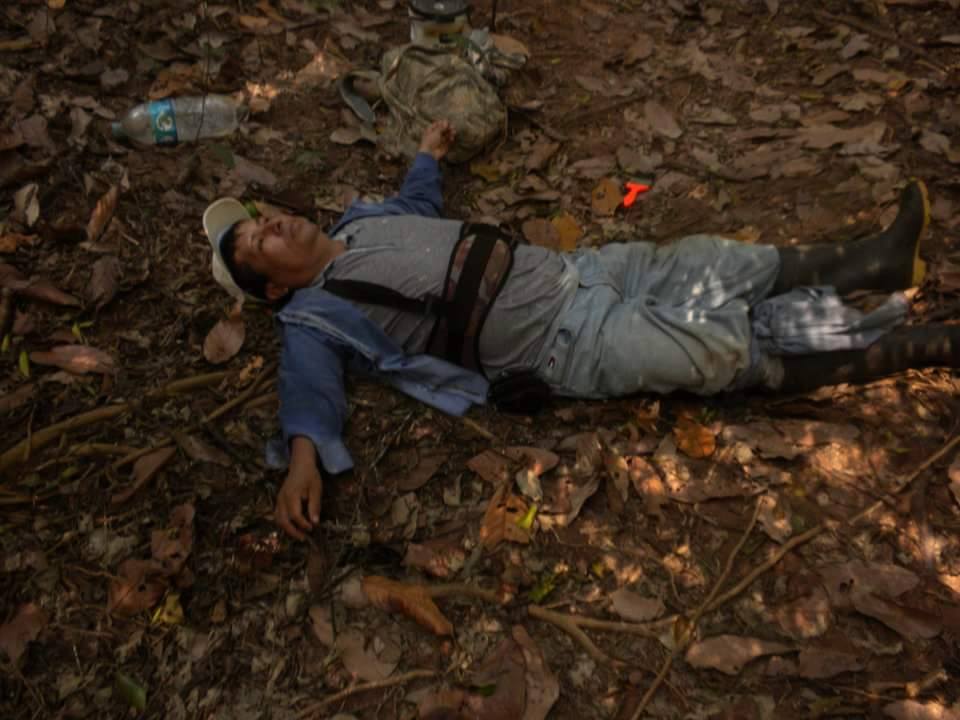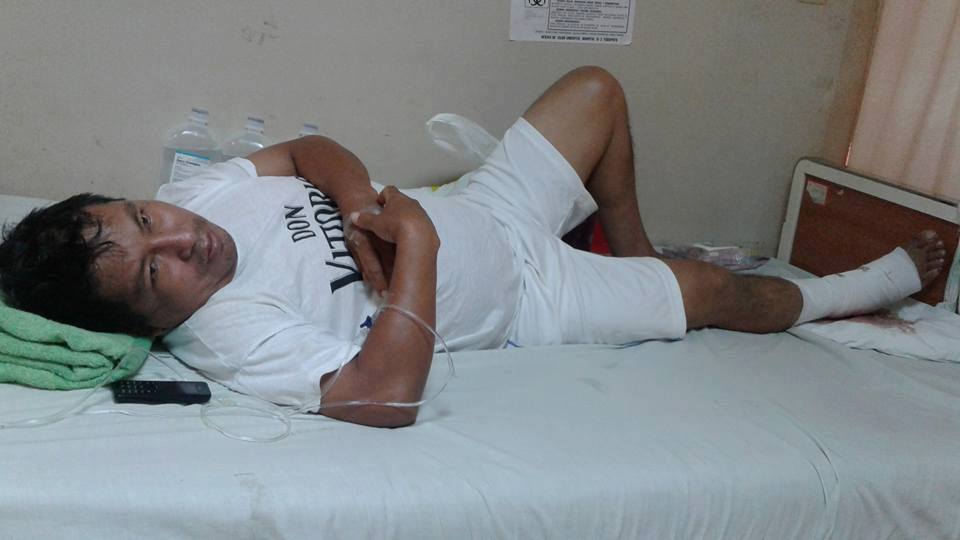- Conservationist Hugo Vásquez, one of the victims of the wildlife ‘trappers,’ is currently unable to walk. This is the lastest reported case.
- A “trapper” includes a loaded gun, triggered by a trip wire that can be pulled by either an animal or human.
- The new Peruvian Forestry Law has not regulated the threat of traps, said Fernando Rubio, a forestry engineer.
On Saturday, August 20, Hugo Vásquez Torrejón was walking through “Ojos de Agua,” a conservation concession located in the province of Picota, Amazon region of San Martín. He needed to paint the frontier landmarks that separates the conservation area from the rest of the forest. But suddenly, in the middle of the walk, he stumbled on a rope that immediately pulled the trigger of a gun located a few meters away. The pellet released from the gun blew Vásquez’s right knee, and he fell to the ground. Vásquez had been a victim of a trap meant to catch wildlife, something the locals refer to as a “trapper”.
“This type of illegal trap to hunt animals is recurrent. The problem is that there are no statistics to certify all cases of people affected by the trappers, there are only anecdotal counts. Even staff from the forestry authority (OSINFOR) have been affected,” Bruno Monteferri, director of project ‘Conservamos por Naturaleza’ of the Peruvian Society for Environmental Law (SPDA), told Mongabay Latam.

Monteferri said that such traps are scattered throughout the Amazon, and the case of Hugo Vásquez Torrejón is but one of many that are reported from time to time in the villages of the Peruvian jungle.
“In private or state-protected areas, it’s hard to install the traps because there is greater security. However, in conservation concessions, such as the one Vásquez was in, it is easier for them to enter because there is not a lot of security. Also, some people have used the area before for other purposes, such as for hunting, and they do not want other people kicking them out of the area,” he continued.
Hugo Vásquez Torrejón is the president of the Conservation Association ‘Ojos de Agua’, which occupies an area of approximately 2,400 hectares of dry tropical forest. Vásquez and his team are responsible for ensuring the safety of an area near Huallaga River in the region of San Martín, where deforestation due to agriculture is increasing, according to the victim.
“Our conservation area is a mole in the middle of areas deforested due to corn and rice crops. People ask me why I dedicate my life to this if I do not gain a lot of money, I tell them that I take care of our water. San Martín is not supplied with water from glaciers; it is supplied by the forest, but nobody notices that,” Vásquez, who is now hospitalized in a clinic in the city of Tarapoto with “excruciating pain,” told Mongabay Latam. He is currently bedridden.
“The day I was shot I was with my son, who was two meters behind me, checking the borders of the concession. After the impact, he had to go back to the city which is three hours away to get help. My son told me that on his return he found me covered in blood. Now that I’m in bed I have had to use three units of donated blood. Thanks to everyone who supported me,” said Vásquez.

According to Monteferri, Hugo Vásquez Torrejón is a conservation referent in Peru. “He uses the profit he makes from green businesses, such as coconut oil production, tourism or using coconut chip as organic carbon, to train farmers in other areas in the field of conservation. He gives value to all the forest standing,” Monteferri said.
It was not an “accident”
Hugo Vásquez Torrejón says this incident was not a simple accident, and he now lives in fear.
“Adrián Fernández Torres is the name of the man who installed the trapper. We know him. And when I got hurt, along with other hunters, he said ‘the first one had fallen’ [referring to Vásquez] [..] That trap was not accidental,” concluded Vásquez, who has reported the case to the police and hopes that they capture the people responsible, despite neither the Forestry Law nor the penal code including such attacks as a crime.
In Peru’s new Forestry Law, injury or death by traps is not included as an offense. If it were, it would cause the police and the prosecutor to act immediately and punish the criminals, the forestry engineer, Fernando Rubio, points out.
“It’s outrageous. I was part of the commission of the creation of the new Forestry Law, and I noted that they should add the issue of trappers so that the crime could be punished. In the penal code, it should be considered as ‘culpable homicide’ because those traps are placed systematically by hunters. They should not be described as simple accidents,” Fernando Rubio, a forestry engineer, told Mongabay Latam.

Rubio explains that there are two reasons why hunters place the traps: to catch animals for self-consumption, for which they install up to three traps in the forest; and for the illegal wildlife trade, for which they install up to 20 traps. Fernando Rubio has followed the issue closely and says that there are clandestine businesses in cities like Tarapoto or Juanjui that function as mechanical workshops, but in reality, secretly engage in the fabrication of these traps.
“According to the Forestry Law, Article 102, in the paragraph of subsistence hunting, it states that hunting in a conservation area is allowed only for native and rural communities,” Rubio continued. “In the case of rural people, it should be regulated by the regional and local government, but this is not followed. The law only speaks generally; it does not point out the trappers as a threat. That needs to change.”
What should be done?
According to Bruno Monteferri, different branches of the government should work together to combat the spread of traps in the Amazon.
“First, the government must develop a campaign to find how many cases there are of victims who’ve lost a leg, deaths, and the total impact on humans. Neglecting these traps can affect children, reporters that go to the area, tourists that visit, among others. The Ministry of Tourism should also be present due to the threat posed by traps to foreigners visiting conservation areas.”
Moreover, Monteferri states that the Ministry of Education should organize orientation campaigns in households. “The Public Ministry should analyze complaints and count them. SERFOR (the national forest and wildlife authority) also has a very important task, and regional governments should regulate the use of weapons for hunting wildlife and punish those who use the trappers” he said.
Current status of the victim
Doctors operated on Hugo Vásquez for the first time on Tuesday, August 23, when they extracted the pellet. However, some splinters remain next to his right knee tendon. On Thursday, October 1, he went through another surgery to rebuild his knee to be able to walk again.
“When I entered the clinic a week ago, I saw two of my friends who were affected by their trappers while hunting. They told me that they will not do it again because now they know how animals suffer when they fall into those traps,” Vásquez told Mongabay Latam.
Any financial support for the Vásquez family is welcome; you can collaborate via this account of the National Bank of Peru: No. 04541187214.
This story was reported by Mongabay’s Latin America (Latam) team and was first published in Spanish on our Latam site on August 31, 2016.
